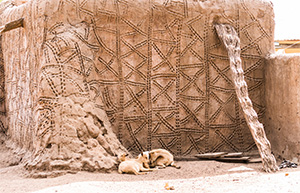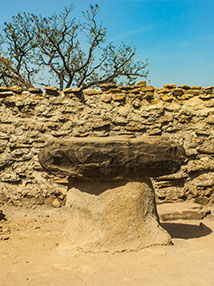ARCHAEOLOGY AND ARCHITECTURE OF THE FRINGE COMMUNITIES
Mole National Park’s fringe communities are endowed with a varied collection of immovable cultural heritage. This collection  includes traditional privately owned dwellings built with earth and thatch, ancient mosques, palaces, religious buildings, historic town defence walls, and cultural landscapes. Examples of such historic places with unique features and architecture worth visiting are the Larabanga Mosque, and historic villages like Sonyor and Daboya. The architecture of the many different ethnic groups in the fringe communities were open to the elements by the traditional knowledge of building and the availability of local construction materials. includes traditional privately owned dwellings built with earth and thatch, ancient mosques, palaces, religious buildings, historic town defence walls, and cultural landscapes. Examples of such historic places with unique features and architecture worth visiting are the Larabanga Mosque, and historic villages like Sonyor and Daboya. The architecture of the many different ethnic groups in the fringe communities were open to the elements by the traditional knowledge of building and the availability of local construction materials.
Indigenous buildings in the fringe communities are constructed mainly of mud, bush poles and thatch. In the north-eastern part of Ghana, circular shaped buildings are constructed and arranged around a central courtyard; roofs are conical and thatched over rafters. Others have flat mud roofs with mud parapets. In the north-western part of Ghana, rectangular shaped structures of interconnected cellular spaces are built with flat mud roofs. In other areas, there are both circular and rectangular shaped structures.
The ancient mosques which are referred to as the ‘Trade Pilgrimage Routes of North-Western Ghana’ were inscribed on the UNESCO Tentative List of World Heritage Properties as one entity, because of the Outstanding Universal Value they represent.
ANCIENT MOSQUES
It is believed that the ancient mosques, which date as far back as the 15th-19th century, were constructed by Islamic traders who frequently travelled through the routes to trade. The architectural styles of these ancient mosques are exceptional, and they portray typical mosque designs. The architectural significance is associated with the values of craftsmanship which still survive in the northern regions of Ghana.
These mosques are identifiable by the horizontal bush poles inserted between the irregular shaped conical buttresses on the elevations, as well as bush pole reinforcement protruding out of the buttresses. Traditional materials such as sun-dried mud bricks, bush poles, cow dung and the residue of shea butter after extraction, were originally used for the construction of the mosques.
The two major architectural styles are the Sudanic style and the Djenne style. The Sudanic style can also be found in Burkina Faso and Cote d’Ivoire, and the Djenne style in Mali. In Ghana, only a few mosques are representative of the Sudanese architectural style. The rest represent the Djenne architectural style.
The Sudanic architectural style is rectangular in shape and has timber framed structures or pillars supporting the flat mud roof. It is characterized by two pyramidal towers (the minaret and mihrab) and by a number of irregular shaped buttresses, with pinnacles projecting above the parapet walls.
LARABANGA MOSQUE
According to the elders, the history of Larabanga village was passed orally from generation to generation. The Larabanga Mosque is one of the oldest mosques in West Africa, and it is the oldest mosque in Ghana. It was built in the early 17th century by Muslim merchants who travelled from North Africa to Ghana to trade in salt and gold.
Larabanga Mosque is a structure built of traditional earthen material and bush poles. It is located about 4 kilometres from Mole National Park. It has buttresses that taper towards the top, forming a parapet around a flat roof system. It also has a unique façade.
The mosque was first restored using the same materials in 1969. However, by 1971 it was dilapidated, and it became necessary to restore it again. Modern materials and techniques were adopted to improve the resistance of the traditional materials against the harsh climatic conditions.
The mosque was restored in February 2003, with a grant from AMERICAN EXPRESS through the WORLD MONUMENTS WATCH FUND. The works were executed by CRATerre ENSAG, a research centre of the Grenoble School of Architecture in France, and the Ghana Museums and Monuments Board.

|


 includes traditional privately owned dwellings built with earth and thatch, ancient mosques, palaces, religious buildings, historic town defence walls, and cultural landscapes. Examples of such historic places with unique features and architecture worth visiting are the Larabanga Mosque, and historic villages like Sonyor and Daboya. The architecture of the many different ethnic groups in the fringe communities were open to the elements by the traditional knowledge of building and the availability of local construction materials.
includes traditional privately owned dwellings built with earth and thatch, ancient mosques, palaces, religious buildings, historic town defence walls, and cultural landscapes. Examples of such historic places with unique features and architecture worth visiting are the Larabanga Mosque, and historic villages like Sonyor and Daboya. The architecture of the many different ethnic groups in the fringe communities were open to the elements by the traditional knowledge of building and the availability of local construction materials.
